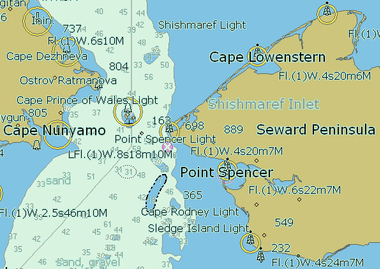Bering land bridge
From Wikipedia, the free encyclopedia.
The Bering land bridge, also known as Beringia, was a land bridge roughly 1600 km (1000 miles) north to south at its greatest extent, which joined present-day Alaska and eastern Siberia at various times during the ice ages.
Biogeographical evidence can prove this land bridge existed far earlier. Similar dinosaur fossils have been found between Asia and North America. For instance the dinosaur Saurolophus was found in both Mongolia and western North America. Relatives of Troodon, Triceratops, and even Tyrannosaurus rex all came from Asia. Fossils in China prove an invasion of Asian mammals into North America 55 million years ago. 20 million years ago, evidence in North America show an interchange of mammalian species. Some, like the ancient saber-toothed cats, have a reoccuring geographical range: Europe, Africa, Asia, and North America. The only way they could reach the New World is through the Bering land bridge. Had this bridge not existed at that time, the fauna of the world would be very different. For instance horses, dogs , and camels would inhabit only the Americas and nowhere else.
The Bering Strait, the Chukchi Sea to the north and the Bering Sea to the south, are all shallow seas. During previous cycles of global cooling, such as the most recent ice age, enough sea water became concentrated in the ice caps of the Arctic and Antarctic that the subsequent drop in eustatic sea levels exposed shallow sea floors. Other land bridges around the world have been created and re-flooded in the same way: approximately 14,000 years ago, mainland Australia was linked both to New Guinea and to Tasmania, the British Isles were an extension of continental Europe via the English Channel, and the dry basin of the South China Sea linked Sumatra, Java and Borneo to the Asian mainland.
The Bering Land Bridge is significant for several reasons, not least because it enabled human migration to the Americas from Asia about 12,000 years ago. Recent studies have indicated that of the people migrating across this land bridge during that time period, only 70 left their genetic print in modern descendents, a minute effective founder population— easily misread as though implying that only 70 people crossed to North America. Sea-going coastal settlers may also have crossed much earlier, but scientific opinion remains divided on this point and the coastal sites that would offer further information now lie submerged in up to a hundred metres of water offshore. Land animals were able to migrate through Beringia as well, bringing mammals that evolved in Asia to North America, mammals such as lions and cheetahs, which evolved into now-extinct endemic North American species, and exporting camelids that evolved in North America (and later became extinct there) to Asia.
The rise and fall of global sea levels has exposed the land bridge in several periods of the Pleistocene. The bridging land mass called "Beringia" is believed to have existed both in the glaciation that occurred before 35,000 BC and during the more recent period 22,000-7,000 YBP. By c. 6000 YBP the coastlines had assumed approximately their present configurations.
Beringia constantly transformed its ecology as the changing climate affected the environment, determining which plants and animals were able to survive. The land mass could be a barrier as well as a bridge: during colder periods, glaciers advanced and precipitation levels dropped. During warmer intervals clouds, rain and snow altered soils and drainage patterns. Fossil remains show that spruce, birch and poplars once grew beyond their northernmost modern range today, indicating there were periods when the climate was warmer and wetter. Mastodon, that depended on shrubs for food, were uncommon in the open dry tundra landscape characteristic of Beringia during the colder periods. In this tundra, mammoths also flourished.
External links
- Bering Land Bridge National preserve
- What is Beringia?
- D.K. Jordan, "Prehistoric Beringia"
- Paleoenvironmental atlas of Beringia: includes animation showing the gradual disappearance of the Bering land bridge
- Yukon Beringia Interpretive Centre
- Paleoenvironments and Glaciation in Beringia
- introduction to "A Material Case for a Late Bering Strait Crossing Coincident with Pre-Columbian Trans-Pacific Crossings"
- An animation of the flooding of the Bering land bridge over the last 20,000 years
References
- Pielou, E. C., After the Ice Age : The Return of Life to Glaciated North America 1992
- Hey, Jody, 2005. "On the Number of New World Founders: A Population Genetic Portrait of the Peopling of the Americas" in PLoS Biol 2005 May 24;3(6):e193 [1]


